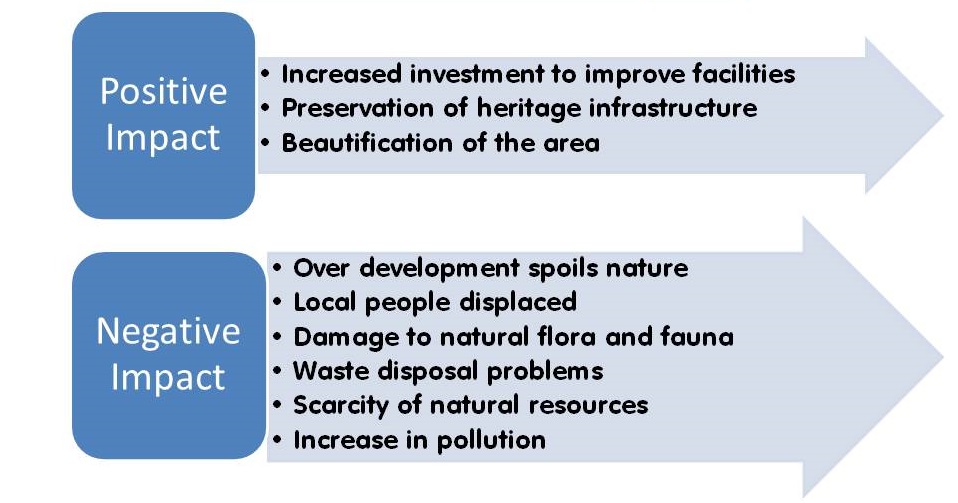
The environment is the surrounding atmosphere or the condition of existence. The impact of tourism on the environment is both positive and negative. This article tackles the major question of the consequences of tourism on the environment. This is a complex area because, while tourism depends on the quality of the environment to attract and sustain visitors, it can also have a detrimental effect on those same environments – and their climate.
This article is designed to provide you with:
- An understanding of the historical dimensions of tourism and the environment
- An appreciation of the negative and positive consequences of tourism on the environment;
- Awareness of broader issues related to tourism and the environment
Below are the most critical ecosystems for tourism:
- Coastlines;
- ocean islands and marine ecosystems;
- Mountains;
- Polar ecosystems;
- Tropical rainforests
Positive impact of tourism on the environment:
In order to attract more tourists, emphasis is placed on the general beautification of the surroundings, regular tree planting and landscaping are carried out to improve the aesthetics. Huge investments are made to improve the facilities in the area like seating areas, blinds, proper sanitation, drinking water etc. There is more emphasis on the preservation of monuments, heritage structures to attract more tourists.
The cause of tourism has helped encourage the conservation of areas of natural beauty and their built heritage. National parks, marine reserves, historical monuments and archaeological sites all benefit economically from tourism. Tourism also encourages good practice in terms of planning and management and stimulates motivation for interpretation and visitor education which, in turn, contributes to the protection of fragile environments and monuments.
Tourism brings a range of benefits to the built environment, as tourism leaves a valuable legacy in terms of architecture, landscapes and urban detail. Tourism is also the economic engine of resorts and is seen as a way to support new ‘mixed’ developments for tourists and residents.
Tourism can be a motivation for the rehabilitation of built and natural environments – historic warehouses on the quays in cities as remote as Oslo and Yokohama have been saved by converting them into retail outlets and catering for a mainly tourism-oriented.
Given these successes, tourism can then be used as a compelling argument for the continued protection of a site if it is threatened. Environmental education of visitors as a means of raising awareness of environmental values has become a major activity in many protected areas and sites of historic interest.
Negative impact of tourism on the environment:
If the beneficial effects of tourism on the environment are numerous, the list of negative consequences is easier to draw up and describe. The scale and significance of the environmental impact depends on both the type of tourism involved and the nature of the resource. New forms of tourism are beginning to introduce new impacts – geotourism, for example, is seeing an increase in the collection of minerals and fossils from important geological sites.
Any type of development requires some interference with nature. Overdevelopment is at the expense of nature. There may be damage to natural flora and fauna. Local populations are displaced due to lack of development in the coastal zone. With more people in the area, more natural resources are needed, which leads to natural resource depletion. Waste disposal problems arise and without proper measures to manage this problem, it can make the situation worse. Due to more footsteps, more transport, more noise, improper waste disposal, pollution is increasing in the region and disturbing the ecological balance of the region.
We can think of climate change as “significant shifts in long-term average weather patterns, which in turn shift the climatic characteristics of a region over time to new conditions.” It is only in recent decades that the consequences of displacement on air quality, and in particular on climate change, have been taken into account. The additional transport activity due to tourism increases carbon emissions with estimates representing around 5% of total global emissions.
Global warming is another consequence, with the accumulation of greenhouse gases in the atmosphere generated by transport, air conditioning and other processes, solar radiation is prevented from escaping from the earth and therefore leads to a warming effect. This has implications for tourist destinations.
Conclusion:
We consider the environment in all its forms and the ecosystems within that environment. It is necessary to maintain the integrity of ecosystems because they provide essential services for the survival of humanity, but we know little about the level of stress that ecosystems can withstand or how they function. An essential element here is to understand the role of tourism within the ecosystem. We must also recognize that the environmental consequences of tourism are substantial, but in fact these consequences are only associated with a small percentage of the world’s population – those who can afford to travel.
Related links
You May Also Like Hospitality Industry Overview | What is travel and tourism | Components of the tourism industry | Types of tourists | Impact of the tourism industry | Social and cultural impact of tourism | Economic impact of the tourism industry | Challenges in the tourism industry | Environmental impact of the tourism industry

